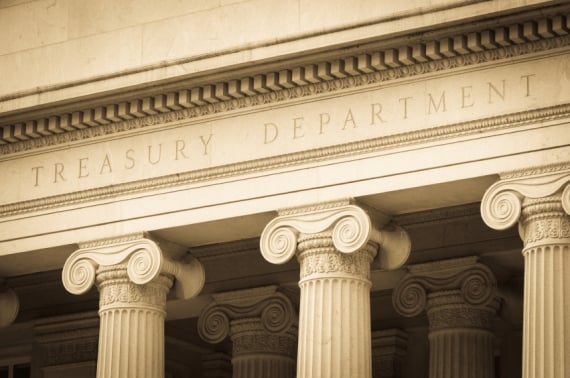Term premium for ten-year notes off the charts; 'usual rules of valuation are just not applying'
A financial model created by economists at the Federal Reserve that includes expectations for interest rates, growth and inflation shows 10-year notes are the most overvalued ever.
As Treasuries hover near record low yields amid stagnant U.S. employment and lingering European debt concern, the so-called term premium, which Fed Chairman Ben S. Bernanke cited in a 2006 speech in New York as a useful guide in setting monetary policy, fell to negative 0.54 percent today, indicating the notes are expensive when compared with the average 0.84 percent for the gauge this decade through mid-2007. The term premium touched negative 0.55 percent on Sept. 2, the lowest ever according to Bloomberg data that begins in 1976.
Treasury 10-year note yields fell to an all-time low today as concern the euro area's debt crisis will cripple financial institutions underpinned demand for the safest assets. A government report Sept. 2 showed no jobs were added in August, reinforcing concern the U.S. economy has slowed which may prompt additional stimulus by the Fed.
“Treasuries are expensive, and everyone knows they are expensive, but given the times, they can stay expensive,” said George Goncalves, head of interest-rate strategy at Nomura Holdings Inc., one of 20 primary dealers that trade directly with the Fed. “Investors aren't buying for yield right now. We are further along in the deleveraging process than we were when the crisis began and people are still willing to buy Treasuries, which tells you that concern over credit globally remains.”
Bond Returns
U.S. government securities returned 2.8 percent in August, the most since the depths of the financial crisis in December 2008, and have gained 8.1 percent this year according to a Bank of America Merrill Lynch index, outperforming the 9 percent decline in the Standard & Poor's 500 Index. Benchmark 10-year yields declined 57 basis points last month, the most since a 71 basis point drop in December 2008, touching a record low of 1.97 percent on Aug. 18.
U.S. payrolls were unchanged last month after an 85,000 gain in July that was less than initially estimated, Labor Department data showed yesterday in Washington. The median forecast in a Bloomberg News survey called for a rise of 68,000. The unemployment rate was unchanged at 9.1 percent.
European Update
Finance ministers from Germany, Finland and the Netherlands are scheduled to meet today to discuss a Finnish demand for collateral in a bailout for Greece. Italy's Senate is set to debate an austerity plan amid a strike called by the nation's biggest union.
Two-year notes traded at almost the record low 0.1568 percent reached on Aug. 9 after the Fed pledged to keep the fed funds target in a zero to 0.25 range until at least mid-2013.
Bond investors have reduced their expectations for inflation as break-even rates on Treasury Inflation Protected Securities, or TIPS, are trading at almost the lowest since October 2010. The break-even rate, calculated from yield differences on 10-year Treasury notes and inflation-indexed U.S. government bonds of similar maturity, has fallen to 1.98 percent from a high this year of 2.67 percent reached on April 11.
Minutes of the Fed's Aug. 9 meeting released Aug. 30 showed policy makers suggested the central bank could offer more support for the economy through focusing on purchases of longer- term securities.
“There is just so much uncertainty out there that the usual rules of valuation are just not applying,” Goncalves said. “Until there is a change in the outlook, Treasuries can stay near these levels.”
--Bloomberg News--







